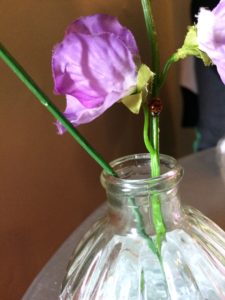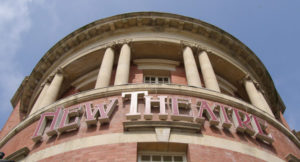
As you step through the doors of the New Theatre, Cardiff you can feel the air of anticipation for what lies ahead. The warmth of the welcome, the buzz of the audience as they gather to enter the auditorium and witness the delights of being entertained by live performers. But what about all the supporting cast?
‘The Theatre Tour’ is a chance to see at first hand all the behind the scenes magic and meet the people that make stars of the performers before our eyes.
Everyone who lives in Cardiff will be familiar with the exterior of the New Theatre as it has been a landmark in the city for over 110 years. This beautiful Edwardian theatre has changed little from the outside over that time but the interior has seen more changes and all of them improvements from performers and theatre goers alike.
As you walk through the doors with an air of expectation for the performance ahead you are absorbed into the very world of this wonderful old theatre and the people who are the beating heart that brings it all to life.
So for me, the chance of a behind the scenes tour of the New Theatre was not to be missed.
Visitors arriving for an evening at the New Theatre are always assured of a warm welcome by the front of house staff. So it was no surprise that when we arrived for our tour of the theatre we were met with genuine hospitality by the volunteer ushers, Colin and Linda who’s job it was to ensure we navigated the theatre in safety without getting lost or left behind.
Our host was Matt Smith, who has been involved with the theatre for many years and is somewhat of an expert when it comes to the history of the building and its previous owners.
We started our tour in the bar where Matt gave us an overview of how the theatre was built. The first owner, Mr Robert Redford and his wife Grace although not from Cardiff, held the city in high regard and Mr Redford worked for many years at another theatre in the city but felt that Cardiff needed a New Theatre, so he built one.
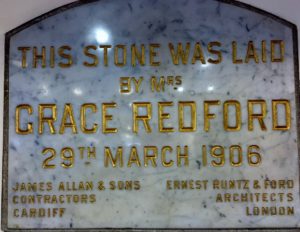
The foundation stone was laid by Grace in March 1906 and the theatre opened with its first production, William Shakespeare’s Twelfth Night in the December of the same year.
The foundation stone is now set in the wall of the ground floor bar alongside the ceremonial trowel which was given to the theatre in its centenary year after being held by the relatives of Robert and Grace who had emigrated to Australia.
At the stage door, we took the route of all actors and performers back stage to the dressing rooms. These were functional, ready and waiting for the next occupants to make them their own for the duration of their stay.
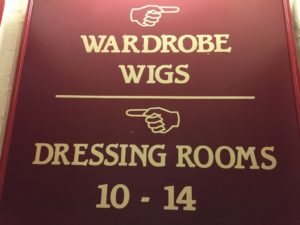
Dressing rooms are located over two floors and in keeping with the old traditions there are even fold down seats for the dressers to wait in the corridors for the arrival back to the dressing room of the actors (it is not considered etiquette for the dressers to be in the actors dressing rooms when they are not there).
It was then time to visit the ‘Fly Floor’ this is where all the scenery and effects are put onto the rope and pulley systems to ensure that they can be lowered and lifted into place at the correct time during the performances.
Del, who is now a ‘Technician’ but who started his career in the theatre as a ‘fly man’, clearly loved what he did (If he didn’t then he was the best actor of them all!). He gave us the opportunity to look back at times past and the hemp rope system which worked on the same lines as sails on a ship by ropes being locked off with a cleat system. Del demonstrated how the scenery would have been flown in and out being worked by a team of 13 burly men on either side of the stage and would have communicated through whistles and hand gestures.
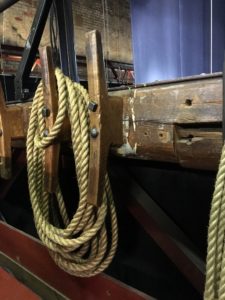
Hemp rope tied off to a cleat.
The system used now is operated using counter weights. Sounding straight forward, it takes much skill and knowledge to get the backdrops and scenery where they’re meant to be, on time and seamlessly.
Exiting the Fly Floor you are on the level of the upper circle. This was a great location to be able to enter the auditorium and have an overview of the theatre. Being close to the ceiling it also gave the opportunity to take in the beautiful architecture that is so familiar but often overlooked.
The highlight of the tour was of course stepping ‘on stage’. There was no roar of the crowd, smell of the greasepaint or limelights but there was the chance to see how the lighting works, explore the role of the assistant director, and the chance to see the all important safety curtain from the other side as well as understanding how it works and why.
Standing on the stage, which is a 1 in 4 rake (this means that it slopes down towards the audience), with the house lights down and the stage lights up it was easy to see why the theatre is indeed a magical place for actors and audiences alike.

The last stop on this tour was at the back of the stalls in the control room where the mixing and control desks are. A sophisticated environment overseen by someone who admitted to coming to the theatre for work experience, and never really left, and having done various jobs has worked his way up.
The tour of the New Theatre leaves you in awe of everyone who works there and brings the touring productions to life.
Theatres and their staff are often referred to as a family, well family or now they certainly are a close knit team and are the unsung heroes behind all the magic and drama that we witness on the stage. From the lady (or gentleman) who mans the stage door to the fly man and the ever diligent fire officer who sits unseen at the side of the stage for every performance to ensure the safety of the actors, the audience and the theatre.
The beauty, history and heritage of this Edwardian theatre is only surpassed by the welcome of its staff. Their love of theatre and their dedication to their craft will continue to make our visits to The New Theatre, Cardiff, special, entertaining and magical.
For further details about forthcoming productions visit www.newtheatrecardiff.co.uk or to book tickets call the Box Office on 02920878889.
